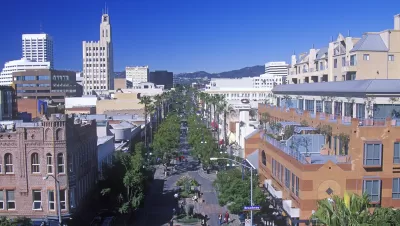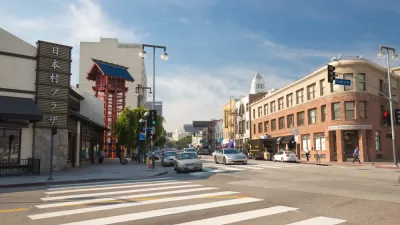An op-ed describing the public health benefits of CEQA reform and urging California's leaders to finalize the end of "Level of Service" as a measure of project impacts.

Since its approval in 2013, environmental and planning advocates in California have applauded Senate Bill 743, the state's latest effort to reform the California Environmental Quality Act (CEQA) and curb greenhouse gas emissions. Public health practitioners should be applauding, too.
With SB 743, the State Legislature, together with the Governor's Office of Planning and Research (OPR), decided it no longer made sense to consider traffic congestion a "significant environmental impact" under CEQA. That decision was certainly a victory for the environmental movement, and much of what has been written about SB 743 celebrates the environmental and land use benefits of the bill. But scant attention has been paid to the potential of the bill to significantly improve health outcomes for urban communities throughout the state.
SB 743 introduces a new logic when it comes to measuring environmental impact of auto delay. Currently, CEQA uses the "Level of Service" (LOS) rating of a street—a metric that assesses traffic congestion—to determine the environmental impact of a project. This outdated regulatory tool suggests that certain projects with the potential to reduce greenhouse gas emissions, such as an urban infill project, could actually have a negative impact on the environment because they could cause or exacerbate local congestion.
LOS is not just an esoteric traffic engineering or legal standard that fills the pages of lengthy environmental documents. It has major implications for the level of traffic analysis required for potentially every major project a city wants to undertake. Even seemingly uncontroversial projects—at least from an environmental perspective—can be waylaid by years of high level analysis and millions of dollars in additional costs. In 2005, for example, San Francisco's extensive proposed bicycle plan was challenged on the grounds that the city's environmental impact assessments under CEQA insufficiently addressed LOS effects.
For a project so clearly aimed at reducing air pollution by increasing bike-ability and getting cars off the road, it's comical that the hold-up came in the form of an environmental challenge. San Francisco's bike plan failed its CEQA technical obligations precisely because of its benefits to the environment: increased bike and pedestrian friendliness, less car reliance, and reduced pollution. Only after a decade of litigation, resulting in a practical moratorium on all bike policy development in the city, did San Francisco produce an environmental impact statement that could satisfy the required LOS traffic analysis.
All that because the LOS standard counterintuitively equates steady vehicle traffic flow with preservation of the environment. Common sense (and climate science) tells us the opposite is true. Urban development projects, when done carefully and constructively, can make commuters, visitors, and residents less likely to travel by car and more likely to travel by foot, bike, or bus. Fewer car trips mean fewer tailpipe emissions, including greenhouse gases, which improves air quality and the overall health and longevity of our planet.
But there are other benefits to varied forms of urban development projects, too. Encouraging active forms of transportation, such as walking, bicycling, and public transit, has been shown to improve health outcomes. For example, roadway and streetscape enhancements that expand facilities for pedestrians, bicyclists, and transit have been shown to increase physical activity. Increased physical activity can reduce obesity, cardiovascular and respiratory diseases, and risk of breast cancer while also improving mental health. And in low-income neighborhoods and communities of color, where residents disproportionately bear the burdens of both poor planning policies and disease, incentives for healthy transportation networks create opportunities to achieve better health.
That is why SB 743 is so important: it will encourage projects that nudge Californians out of their cars and onto their feet (and bike or bus or train).
SB 743 tasked OPR with revising the CEQA Guidelines to establish a new metric that "shall promote the reduction of greenhouse gas emissions, the development of multimodal transportation networks, and a diversity of land uses." In August 2014, OPR released its "Preliminary Discussion Draft" of updates to the CEQA Guidelines. OPR received numerous public comments, and has indicated that a revised draft will be released in the near future. In fact, we expect to see another draft any day now.
OPR's initial draft guidelines proposed Vehicle Miles Traveled (VMT) as a substitute for LOS, and most infill developers and environmental advocates have cheered this recommended change. It's understandable why. Assuming the proposal sticks, lead agencies will no longer have to measure whether a project makes it less convenient to drive. Instead, they can focus on whether a project will contribute to other state goals, such as reducing greenhouse gases. The public health community is cheering too. Projects that have the potential to add quality, affordable housing, jobs, or services to neighborhoods with existing amenities and infrastructure, or those that enhance safety and comfort for people walking, biking, and using public transit, are the very same projects that will make it easier for Californians to lead healthier lives.
Unfortunately, the proposal has been under attack for some time, and a bill was introduced (although it has since been revised) to delay the proposed reforms even though they haven't even been finalized yet. Some argue that moving away from LOS would add additional burdens to the development review process at a time when the state is facing a housing affordability crisis. They claim that a change to VMT would negatively affect future projects, presumably because they believe there will be increased costs associated with environmental review.
For more than two generations, Californians have borne the costs of auto-centric development. Enough is enough. It's true that SB 743 is no magic bullet for either public health or the environment. But it's a good first shot. In the long-term, new technology will transform the way we move from place to place, how we work, and where we live—and this means our public health challenges will shift, too. But we needn't wait to find and implement solutions when a clear opportunity to make improvements is available. Our cities have been designed for disease and injury for far too long. We in the public health community look forward to partnering with our allies in the planning, environmental, and development fields to ensure that this law can achieve its full potential.
Benjamin D. Winig is the Senior Staff Attorney and Program Director for ChangeLab Solutions, a national non-profit dedicated to building healthier communities for all through better laws and policies.

Alabama: Trump Terminates Settlements for Black Communities Harmed By Raw Sewage
Trump deemed the landmark civil rights agreement “illegal DEI and environmental justice policy.”

Planetizen Federal Action Tracker
A weekly monitor of how Trump’s orders and actions are impacting planners and planning in America.

Why Should We Subsidize Public Transportation?
Many public transit agencies face financial stress due to rising costs, declining fare revenue, and declining subsidies. Transit advocates must provide a strong business case for increasing public transit funding.

Understanding Road Diets
An explainer from Momentum highlights the advantages of reducing vehicle lanes in favor of more bike, transit, and pedestrian infrastructure.

New California Law Regulates Warehouse Pollution
A new law tightens building and emissions regulations for large distribution warehouses to mitigate air pollution and traffic in surrounding communities.

Phoenix Announces Opening Date for Light Rail Extension
The South Central extension will connect South Phoenix to downtown and other major hubs starting on June 7.
Urban Design for Planners 1: Software Tools
This six-course series explores essential urban design concepts using open source software and equips planners with the tools they need to participate fully in the urban design process.
Planning for Universal Design
Learn the tools for implementing Universal Design in planning regulations.
Caltrans
Smith Gee Studio
Institute for Housing and Urban Development Studies (IHS)
City of Grandview
Harvard GSD Executive Education
Toledo-Lucas County Plan Commissions
Salt Lake City
NYU Wagner Graduate School of Public Service





























